Generative AI vs Predictive AI: Which One Dominates the AI Revolution?
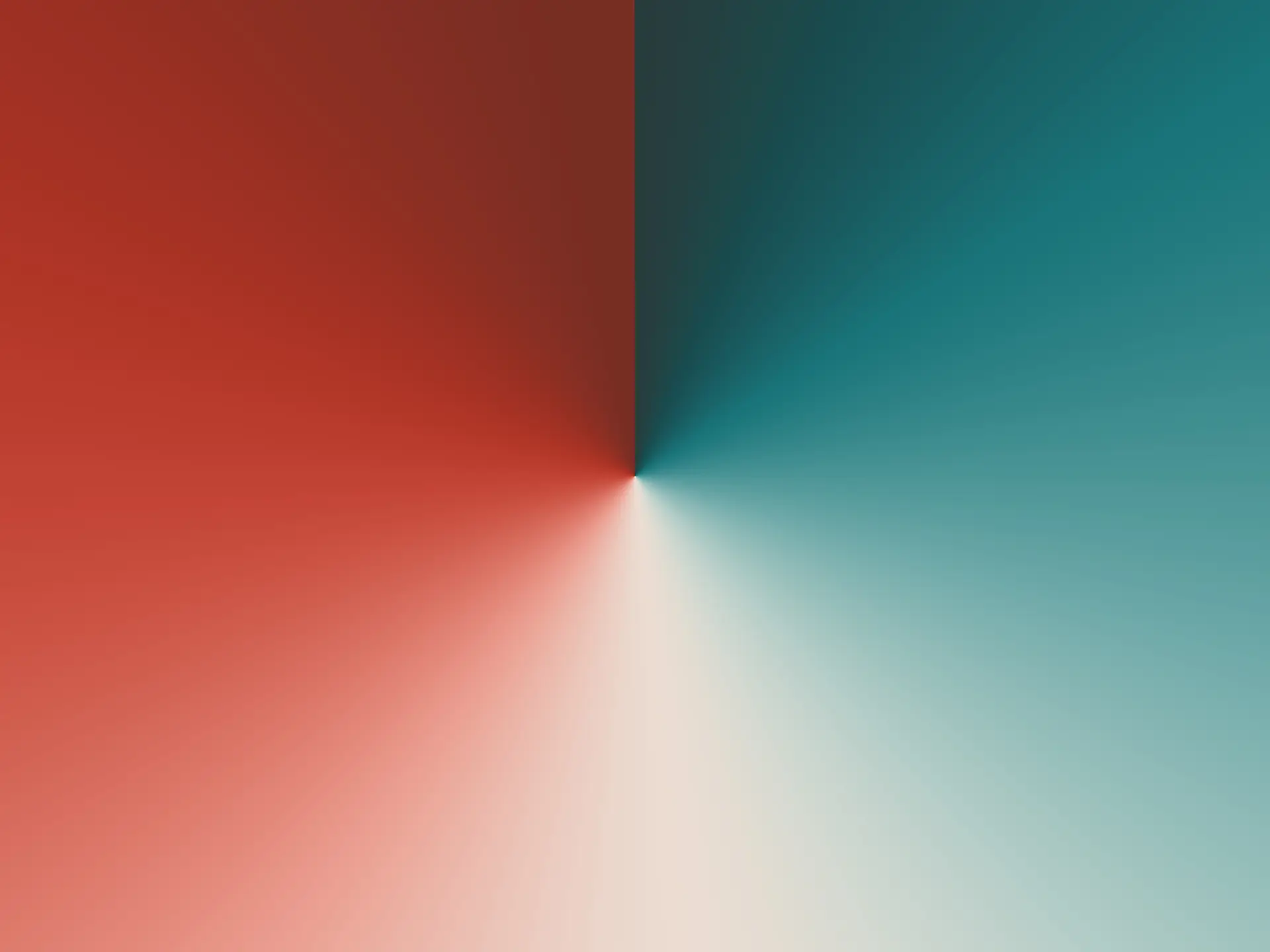
In the complex yet impressive world of AI development, Generative AI vs Predictive AI are like two sides of the same coin, each with its own incredible set of skills.
Generative AI is intended to create—whether it’s lifelike images, music, or text that mirrors human creativity. Predictive AI, by comparison, is about foresight—assessing current data to forecast future trends, which enables businesses to make data-driven decisions with enhanced confidence. Isn’t it impressive?
But what’s the essence of these two powerful technologies? As experts in the AI field, we’ll compare Generative AI vs Predictive AI, explore the mechanisms that power them, their routine and breakthrough uses, and their huge impact on different sectors.
What is Generative AI?
Generative AI is a type of deep-learning model that can create content after being pre-trained on text, images, or other media. Unlike simpler AI models (Decision Trees, k-Nearest Neighbors, Random Forests, etc) that analyze and recognize patterns, Generative AI creates something entirely new. The generative AI definition reveals its innovative nature, powered by advanced technologies such as:
- Generative Adversarial Networks (GANs): GANs involve two neural networks—a generator and a discriminator. The generator produces new data samples, while the discriminator assesses these samples against real data, improving over time to create highly realistic data. This process, similar to a cat-and-mouse game, improves the generator’s ability to produce realistic data that can deceive the discriminator.
- Variational Autoencoders (VAEs): VAEs represent another sophisticated neural network architecture within Generative AI. They reduce input data into a smaller, latent representation and then rebuild it into data that closely resembles the original. That allows VAEs to generate new, unique content based on the patterns learned through training.
Applications of Generative AI
Gartner predicts that by 2026, over 100 million people will use generative AI to help with their work. McKinsey analyzed 63 different ways generative AI could be used and found that if all were implemented, it could add between $2.6 trillion and $4.4 trillion to the global economy. When examining the generative AI definition, we see its role in pushing the boundaries of what’s possible in digital creativity. Here’s how it’s leaving its mark:
| Field | Generative AI Use Cases | Examples |
| Creative Arts | Generates music, visual art, and writing content similar to human-created works. | AI-generated artworks like those from DALL-E by OpenAI, AI-composed music by AIVA . |
| Product Design | Creates prototypes and refines designs based on specific criteria and user feedback. | Nike uses AI to design customized shoes; Airbus uses AI for aircraft design. |
| Data Augmentation | Generates synthetic data to replicate real-world datasets to enhance ML model training. | Tesla uses synthetic data to train its autonomous car systems. |
| Customer Service | Powers chatbots and virtual assistants that provide human-like responses to customer inquiries and offer 24/7 support. | AI chatbots like ChatGPT by OpenAI, customer service bots by Zendesk. |
| Finance | Simulates financial scenarios, generates synthetic financial data for stress testing, and creates automated reports and analyses. | JPMorgan Chase uses AI for financial forecasts, Goldman Sachs uses AI-driven risk management. |
| Healthcare | Produces realistic medical images, simulates patient data, and aids drug discovery by modeling molecular structures. | IBM Watson for drug discovery, AI-generated medical images for training by Google Health. |
| Marketing and Advertising | Creates personalized marketing content, such as emails, advertisements, and social media posts, tailored to individual user profiles. | Coca-Cola uses AI to create customized ad campaigns, and Mailchimp employs AI-driven email marketing. |
| Architecture and Engineering | Generates design proposals, simulates construction processes, and creates detailed architectural visualizations. | Autodesk AI for architectural design, AI-driven construction simulations by Bentley Systems. |
Advantages of Generative AI for Businesses
At its core, the generative AI meaning is about creating new possibilities in digital art and communication. Here are some benefits to highlight its impact:
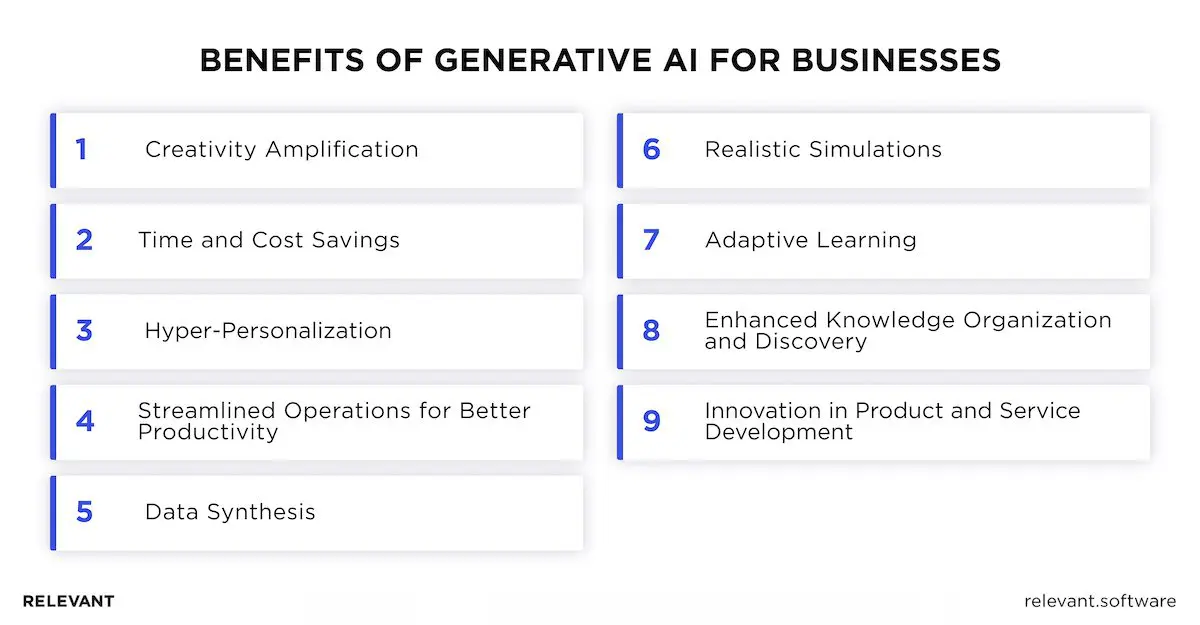
1. Creativity Amplification
Generative AI enhances creativity by generating new ideas, designs, and solutions. It helps artists, designers, and marketers create original content, from artwork and music to innovative product designs, broaden creative horizons, and drive innovation.
2. Time and Cost Savings
Generative AI significantly reduces the time and cost associated with these tasks by automating content creation and data generation processes. Businesses can produce high-quality outputs more quickly and with fewer resources, which optimizes their operational efficiency.
3. Hyper-Personalization
Generative AI enables hyper-personalization by analyzing individual customer data to create tailored experiences. That comprises personalized marketing campaigns, custom product suggestions, and tailored customer service experiences to boost customer satisfaction and loyalty.
4. Streamlined Operations for Better Productivity
Generative AI optimizes business workflows, which leads to greater efficiency and productivity. It perfectly automates repetitive tasks, leaving employees more time to focus on strategic and creative work, which increases overall productivity.
5. Data Synthesis
Generative AI is adept at synthetic data generation that closely resembles real-world datasets. That becomes especially crucial for training machine learning models when actual data is scarce, expensive, or contains privacy concerns.
6. Realistic Simulations
The generative AI meaning encompasses the technology’s role in simulating realistic environments and scenarios for various uses. In the automotive and aerospace sectors, it is easier to experiment with different conditions and scenarios without the risks and costs of actual trials.
7. Adaptive Learning
Generative AI applications can adapt and learn from new data inputs, which consistently enhances its performance. This adaptive learning feature ensures that the AI models stay relevant and effective, even as they face new and changeable data patterns.
8. Enhanced Knowledge Organization and Discovery
Generative AI helps organize and uncover knowledge by generating insights from large datasets. It can briefly identify patterns, correlations, and trends that might be missed by human analysts, which provides insights for strategic decision-making.
9. Innovation in Product and Service Development
Generative AI facilitates the innovation of new products and services by rapidly prototyping and iteration of ideas. This rushes the development timeline, which lets businesses get new products out faster and ahead of the competition.
Challenges of Generative AI
In fact, 80% of generative AI vs predictive AI initiatives stall at the pilot stage. To avoid this, AI engineers have to solve some problems such as:
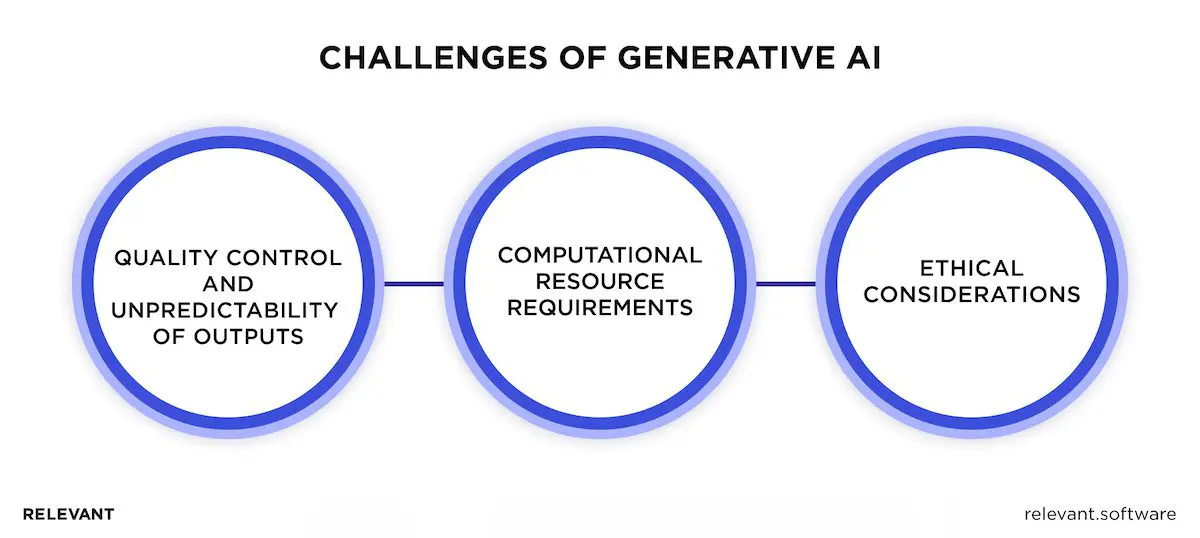
Quality Control and Unpredictability of Outputs
Content generated by artificial intelligence can sometimes be unpredictable, and the results can be either poor quality or completely wrong. This unpredictability makes it difficult to rely solely on AI for critical tasks without human oversight. To mitigate these risks and maintain high standards of output quality, it is essential to apply rigorous quality control measures and ensure continuous oversight.
Computational Resource Requirements
Deep learning-based generative AI models need a lot of computational power and resources. Preparation of these models can be laborious and costly and requires access to advanced hardware, such as GPUs or TPUs, as well as significant amounts of energy. This heavy resource demand can be difficult for smaller businesses or those with budget constraints. Optimizing AI models for efficiency and exploring cloud-based solutions can help manage these resource requirements.
Ethical Considerations
Generative AI can create highly realistic but potentially misleading content, such as deep fakes. These AI-produced images, videos, or audio recordings mimic real people, often very convincingly. The ethical implications of such technology are profound, as it can be used to spread misinformation, commit fraud, and infringe on personal privacy. To address these ethical issues, it is necessary to develop robust detection mechanisms and establish clear guidelines and regulations to govern the use of Generative AI.

What is Predictive AI?
Seemingly, Predictive AI capabilities are partially encrypted in its name. Predictive artificial intelligence supercharges the age-old practice of using statistics to forecast future events with modern technology.
Predictive AI follows a structured approach to analyzing vast amounts of data by advanced statistical models and ML algorithms to identify hidden patterns and relationships. It does this more quickly and (ideally) more accurately than traditional methods. While it can’t promise 100% accuracy, it offers businesses a powerful tool to prepare for what’s ahead and create personalized customer experiences.
What is predictive AI’s inner workings? It starts with data collection from various sources. The data is then preprocessed to ensure it is clean and properly structured. Next, ML algorithms analyze the data to learn patterns. The models are fine-tuned through the training and testing phases.
Common models utilized in Predictive AI include:
- Regression: Predicts continuous outcomes (e.g., linear and logistic regression).
- Decision Trees: Splits data into branches to make predictions based on decision rules (e.g., random forests, gradient boosting machines).
- Neural Networks: Consists of interconnected nodes processing information in layers, ideal for complex patterns.
- Support Vector Machines (SVMs): Finds optimal hyperplanes for classification and regression tasks.
- K-Nearest Neighbors (KNN): Predicts outcomes based on the distance to the nearest data points.
Once ready, these models are deployed to make predictions on new data. Predictive AI continues to improve through a feedback loop; it constantly learns and adjusts based on the accuracy of its predictions compared to actual outcomes.
Applications of Predictive AI
Predictive AI is changing the game in many industries by offering smart insights and helping with better decision-making. Here’s a look at some of the key uses:
| Field | Predictive AI Use Cases | Examples |
| Healthcare | Forecasts disease outbreaks, patient outcomes, and treatment efficacy by examining medical records and health data. | Johns Hopkins uses predictive AI to forecast COVID-19 trends and IBM Watson – for personalized treatment plans. |
| Finance | Analyzes market trends, assesses risks, and forecasts financial performance based on historical and real-time data. | JPMorgan Chase uses predictive AI for market analysis, Goldman Sachs for risk management and trading strategies. |
| Manufacturing | Anticipates equipment failures, optimizes maintenance schedules, and improves production processes by sensor data and operational metrics analysis. | Siemens uses predictive AI for predictive maintenance, GE – for manufacturing process optimization. |
| Retail | Forecasts consumer behavior, optimizes inventory levels, and provides personalized shopping experiences through customer data and purchase history analysis. | Amazon utilizes predictive AI for product recommendations and Walmart for inventory management. |
| Supply Chain | Forecasts demand, optimizes inventory levels, and predicts supply chain disruptions by logistical data and market trends analysis. | Procter & Gamble uses predictive AI for supply chain optimization, DHL – to predict delivery times and manage logistics. |
| Transportation and Logistics | Optimizes routing, predicts maintenance needs, and forecasts demand by transportation data usage and traffic patterns analysis. | UPS uses predictive AI for route optimization and Tesla – for autonomous vehicle maintenance prediction. |
| Energy | Foresees energy consumption, optimizes energy distribution, and predicts equipment maintenance needs. | National Grid uses predictive AI to manage energy distribution and Schneider Electric – for predictive maintenance. |
| Marketing | Analyzes consumer data to predict future buying behavior, optimize ad placements, and personalize marketing campaigns. | Spotify uses predictive AI for personalized playlists and recommendations and Google Ads – for targeted advertising. |
| Education | Analyzes student data to predict academic performance, personalize learning paths, and improve retention rates. | Coursera uses predictive AI to personalize learning experiences, Arizona State University – to predict student success. |
Across all these fields, predictive AI enhances efficiency, reduces costs, and drives innovation, which makes it an indispensable tool for modern businesses.
Related – How to create an AI
Advantages of Predictive AI
Predictive analytics tools have become standard in large corporations, and now, thanks to technological advancements and democratization, small and medium-sized enterprises (SMEs) are adopting them to enhance user experiences, refine their products, and deliver excellent after-sales service. Here are the main benefits that Predictive AI can offer.
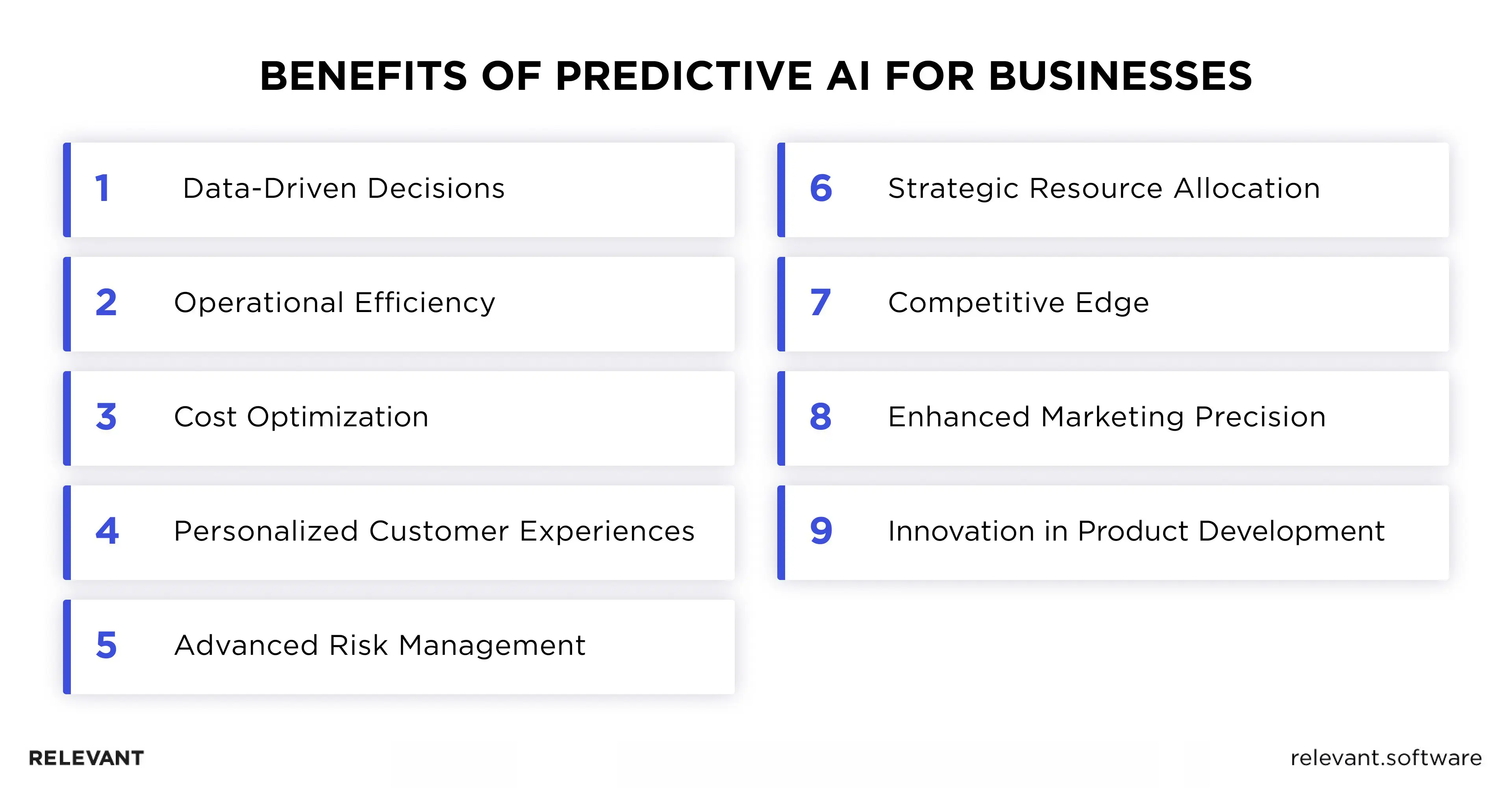
1. Data-Driven Decisions
Predictive AI allows businesses to make decisions grounded in data rather than relying on gut feelings. By examining past data and spotting trends, companies can predict outcomes more accurately and make well-informed choices, which minimizes the chances of expensive mistakes.
2. Operational Efficiency
Predictive AI automates complex data analysis processes, significantly reducing the time and effort required for manual analysis. This automation streamlines operations, enhances productivity, and allows employees to focus on high-value tasks that require human expertise.
3. Cost Optimization
By predicting future trends and identifying potential issues before they arise, predictive AI helps businesses optimize their resource allocation. For example, predictive maintenance can forecast equipment failures, which allows timely interventions that prevent costly downtime and extend the lifespan of machinery.
4. Personalized Customer Experiences
Predictive AI studies customer habits and likes to create unique personalized experiences. This way, businesses can tailor their marketing efforts, product recommendations, and customer service interactions to meet individual needs, which increases customer satisfaction and loyalty.
5. Advanced Risk Management
Predictive AI enhances risk management by identifying potential threats and vulnerabilities across various domains, such as financial risks, cybersecurity threats, and supply chain disruptions. This proactive approach allows businesses to implement preventive measures and mitigate risks effectively.
6. Strategic Resource Allocation
With predictive insights, businesses can allocate resources more strategically. For instance, predictive demand forecasting helps retailers optimize inventory levels, which ensures they meet customer demand without overstocking or understocking.
7. Competitive Edge
Predictive AI gives businesses a competitive advantage by enabling them to anticipate market trends and consumer behavior. With this foresight, companies can innovate, swiftly adjust to changes, and maintain a lead over competitors in a dynamic market.
8. Enhanced Marketing Precision
Predictive AI refines marketing strategies by analyzing consumer data and predicting future behavior. This simplifies the creation of highly targeted campaigns that resonate with the audience, boost engagement, and make every dollar count.
9. Innovation in Product Development
Predictive AI enhances product development by studying market trends and customer feedback to predict future needs. This enables companies to create products and services that align with evolving customer preferences, ensuring they remain relevant and innovative.
Challenges of Predictive AI
Predictive AI offers powerful benefits, but effective implementation comes with several challenges. Here’s a closer look at what businesses might face:
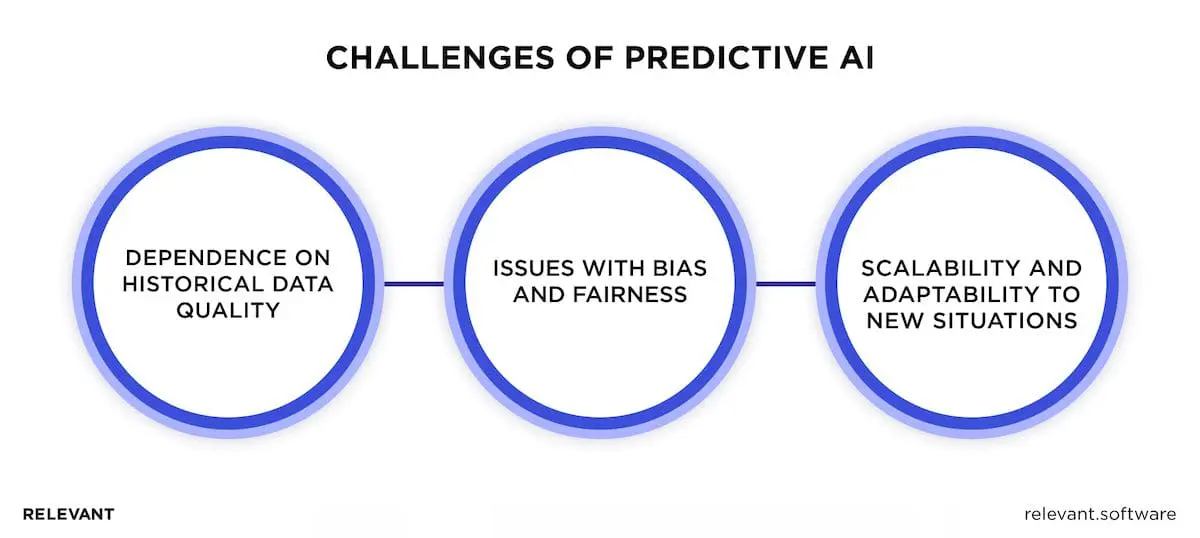
Dependence on Historical Data Quality
Predictive AI relies heavily on the quality and completeness of historical data. The predictions won’t be accurate if the data is wrong, has missing pieces, or is biased. Reliable AI performance requires constant data cleaning, validation, and updates, which can be resource-intensive and complex.
Issues with Bias and Fairness
Predictive AI models might inherit biases found in the training data, which causes unfair or biased results. For example, if the historical data contains societal biases, the AI could reflect these in its predictions. To address this issue, AI engineers must carefully analyze data, conduct regular audits, and implement fairness-aware algorithms to ensure that the AI operates ethically and equitably.
Scalability and Adaptability to New Situations
Predictive AI models can struggle with scalability and adaptability. To keep models accurate, they must be updated and retrained regularly due to changes in business environments and data patterns. Additionally, scaling predictive AI solutions to handle larger volumes of data and more complex scenarios can be difficult. This requires robust infrastructure, significant computational resources, and a strategic approach to model management and deployment.
Generative AI vs Predictive AI: Comparative Analysis
Predictive AI vs Generative AI differs in functions, though their applications sometimes overlap. Are you eager to understand what these technologies can do for your business? In a table, we’ve compared capabilities, AI applications, and, of course, the difference between generative AI and AI predictive.
| Aspect | Generative AI | Predictive AI |
| Core Functionality | Generates new original content like images, text, and music through complex algorithms and deep learning models such as GANs and VAEs. | Forecasts future events based on historical data with statistical algorithms and ML models like regression analysis, decision trees, and neural networks. |
| Applications | Creative Arts (music, art, literature) Product Design (prototypes, optimization) Data Augmentation (synthetic data for ML models) | Healthcare (disease prediction, patient outcomes) Finance (market trends, risk assessment) Retail (customer behavior, inventory management) |
| Strengths | Creativity: Produce original content Innovation: Enhances creative processes Versatility: Useful in various fields, from entertainment to industrial design | Accuracy: Provides data-driven predictions Efficiency: Streamlines operations Risk Management: Identifies and mitigates risks |
| Challenges | Quality Control: Maintain content quality Resource Intensive: Requires extensive computational power Ethical Concerns: Risk of harmful or misleading content | Data Dependency: Relies on data quality and quantity Bias and Fairness: Risks of inherited biases Complexity: Difficult integration and continuous adaptation |
| Integration | Enhances creative processes, assists in product development, and generates realistic training data. | Improves decision-making, streamlines operations, and helps with risk management across various sectors. |
Integration and Synergy
When combined, these technologies can create even more powerful and versatile systems. Here’s how Generative AI vs predictive AI can complement each other and some examples of hybrid AI systems that leverage both approaches:
- Better Decision Making: Predictive AI forecasts future trends, while Generative AI creates responses to those predictions, which helps businesses stay ahead. For example, retail companies can use Predictive AI to anticipate shopping trends and Generative AI to design targeted marketing campaigns.
- Personalized Experiences: Predictive AI analyzes customer preferences, and Generative AI crafts personalized content, which improves satisfaction and loyalty. For instance, streaming services use Predictive AI to understand viewing habits and Generative AI to suggest movies and shows.
- Optimized Operations: Predictive AI predicts equipment needs, and Generative AI designs maintenance plans, which reduces downtime and boosts efficiency. For example, manufacturing plants use Predictive AI to foresee equipment failures and Generative AI to schedule timely maintenance.
- Smart Content Creation: Predictive AI spots trending topics, and Generative AI creates content, which increases relevance and engagement. News websites use Predictive AI to identify trending news and Generative AI to draft articles quickly.
- Risk Management: Predictive AI assesses risks, and Generative AI creates mitigation strategies, which help navigate uncertainties. Insurance companies use Predictive AI to predict claim trends and Generative AI to design risk mitigation plans.
- Improved Security: Predictive AI detects threats, and Generative AI generates responses, which enhances safety. Cybersecurity firms use Predictive AI to identify potential breaches and Generative AI to automate incident responses.
It’s obvious that the Predictive AI vs. Generative AI combination grants smarter, more adaptive, and creative solutions across various industries.
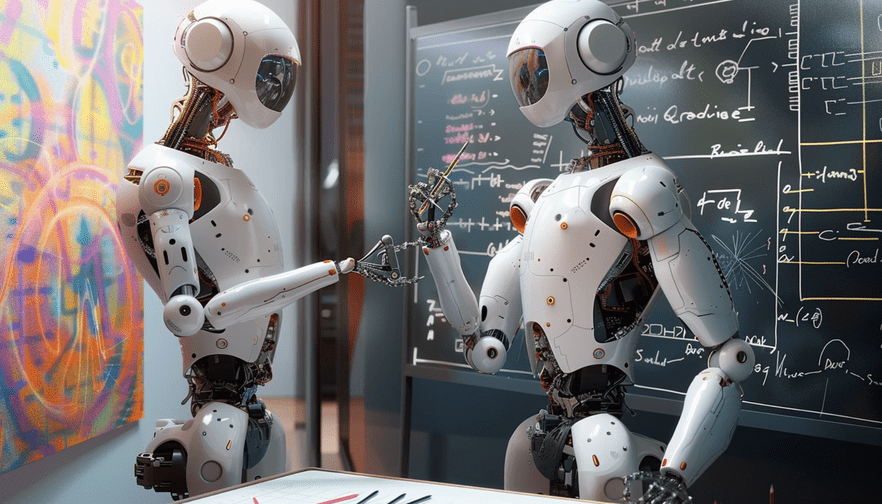
As AI advances, the distinction between generative AI and predictive AI becomes less clear. New AI systems emerge to integrate both generative and predictive capabilities. Rather than rely on one set of algorithms for predictions and another for creation, these advanced systems combine functions and deliver predictive insights while generating new content in one package.
Generative AI vs Predictive AI: Bottomline
So, let’s summarize the above – Generative vs Predictive AI models. Predictive AI shows you what’s likely to happen, and Generative AI helps you think on your feet and respond brilliantly. You get the best of both worlds – foresight and innovation working hand in hand.
At Relevant Software, we can bring these AI capabilities together to supercharge your business. Whether you want to streamline operations, personalize marketing, or speed up product development, we’ve got you covered, ensuring you get the most out of Predictive vs generative AI.
Ready to see how this works in real life? Contact us! With our talented AI engineers, you’ll be ready to tackle any challenge the future throws at you.



